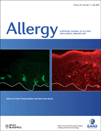Maternal allergic disease does not affect the phenotype of T and B cells or the immune response to allergens in neonates
Edited by: Jean Bousquet
Abstract
To cite this article: Rindsjö E, Joerink M, Johansson C, Bremme K, Malmström V, Scheynius A. Maternal allergic disease does not affect the phenotype of T and B cells or the immune response to allergens in neonates. Allergy 2010; 65: 822–830.
Background: It is hypothesized that the in utero environment in allergic mothers can affect the neonatal immune responses. The aim of this study was to analyse the effect of maternal allergic disease on cord blood mononuclear cell (CBMC) phenotype and proliferative responses upon allergen stimulation.
Methods: Peripheral blood mononuclear cells (PBMC) from 12 allergic and 14 nonallergic mothers and CBMC from their children were analysed. In the mothers, we determined cell proliferation, production of IL-4 and expression of FOXP3 in response to allergen stimulation. In the children, we evaluated cell proliferation and FOXP3 expression following allergen stimulation. Furthermore, expression of different homing markers on T cells and regulatory T cells and maturity of the T cells and B cell subsets were evaluated directly ex vivo.
Results: The timothy- and birch-allergic mothers responded with increased proliferation and/or IL-4 production towards timothy and birch extract, respectively, when compared to nonallergic mothers. This could not be explained by impairment of FOXP3+ regulatory T cells in the allergic mothers. CBMC proliferation and FOXP3 expression in response to allergens were not affected by the allergic status of the mother. Also, phenotype of T cells, FOXP3+ regulatory T cells and B cells was not affected by the allergic status of the mother.
Conclusion: Our results suggest that maternal allergic disease has no effect on the neonatal response to allergens or the phenotype of neonatal lymphocytes. The factors studied here could, however, still affect later development of allergy.




